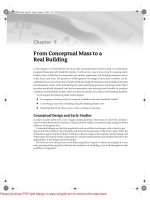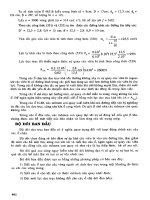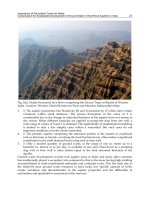Water Stress Part 9 pdf
Bạn đang xem bản rút gọn của tài liệu. Xem và tải ngay bản đầy đủ của tài liệu tại đây (1.61 MB, 18 trang )
The "Pot-in-Pot" System Enhances
the Water Stress Tolerance Compared with Above-Ground Pot
133
southeast Spain; they were collected in November 2005 and stored dry at 5 °C. The pots
were arranged in a 9 5 configuration, had an inverted pyramid form, and measured 60
30 17 cm (240 cm
3
volume). The plants were transplanted to black PVC pots (cultivation
pot) of 2.5 L volume, 16 cm upper external diameter, and 15 cm height. The pots were filled
with a mixture of white peat (40%), clay loam soil (30%), and sand (30%). After
transplantation, all the plants where cut back to approximately 20 cm height.
The experiment was performed in an open-air plot of 70 m
2
at the Tomás Ferro
Experimental Agro-Food Station of the Polytechnic University of Cartagena (UPCT) (37° 35'
N, 0° 59' W). Transplantation of seedlings to cultivation pots was performed on 15 March
2009, and the experiment took placed from 1 April 2009 to 4 December 2009. Weather
conditions were taken from a meteorological station sited 100 m from the experimental plot.
The mean hourly values of temperature, relative humidity, and solar radiation were
registered (Fig. 1).
Temperature (ºC)
10
20
30
40
Mean
Minimum
Maximum
Relative Humidity (%)
40
50
60
70
80
90
100
Mean
Minimum
Maximum
Months
Apr May Jun Jul Aug Sep Oct Nov Dec
DPV (kPa)
0
1
2
3
Mean
Minimum
Maximum
Months
Apr May Jun Jul Aug Sep Oct Nov Dec
PPFD (mol·m
-2
·s
-1
)
400
600
800
1000
1200
1400
1600
1800
2000
DLI (mol·m
-2
·day
-1
)
0
10
20
30
40
Maximum PPFD
DLI
A
B
C
D
Fig. 1. Mean, minimum and maximum monthly environmental temperature (A), relative
humidity (B) and vapor pressure deficit (DPV) (D), and maximum photosynthetic photon
flux density (PPFD) and daily light integral (DLI) (C).
Water Stress
134
A drip irrigation system was installed, with one dripper per plant (2 L·h
-1
) connected to two
spaghetti tubes (one each side of every pot). Local irrigation water (pH 7.2; electric
conductivity 1.7 dS m
-1
) was used, containing Ca
2+
(95 mg L
-1
), Mg
2+
(69 mg L
-1
), Na
+
(145
mg L
-1
), Cl
-
(232 mg L
-1
), and HCO
3
-
(110 mg L
-1
). Both treatments were irrigated between
12:00 and 14:00 h with the same frequency and volume of water. Irrigation frequency was
set so that soil matric potential (SMP) reached values of -60 and -80 kPa in AGP. To meet
this criterion, irrigation frequency varied according to the season: two irrigations per week
in spring and autumn, and three irrigations per week in summer. Irrigation amounts were
programmed to obtain leaching of 15% to 20% in AGP, which produced irrigation water
volumes between 400 and 700 mL per pot. Greater volumes of water were applied in
summer and when the time between irrigations was greater (e.g., after the weekend). The
leachate in PIP was not collected.
2.2 Experimental design and statistical analysis
The PIP system consisted of placing cultivation pots in pots already buried in the ground.
The buried pots were made of black PVC and contained many small drainage holes to
ensure drainage (5.5 L volume, 17 cm upper exterior diameter, and 30 cm height). An air
chamber of 15 cm separated the bases of both pots. Once the pots were buried in the
ground, the plot was covered with a plastic permeable mulch (Horsol 140 g m
-2
; Projar
S.A., Valencia, Spain), which was covered with a 4 cm layer of gravel (~2 cm dia.) (Fig. 2).
Fig. 2. Pot-in-Pot general design.
A total of 220 cultivation pots were placed in 10 rows, 60 cm apart, so that each row had 22
cultivation pots (Picture 1). These were placed 55 cm apart, buried pots (PIP) alternating
The "Pot-in-Pot" System Enhances
the Water Stress Tolerance Compared with Above-Ground Pot
135
with above-ground pots (AGP). A CR1000 datalogger and an AM16/32 multiplexer
(Campbell Scientific, Logan, UT) were installed in the center of the plot connected to eight
temperature probes (Termistor 107, Campbell Scientific S.L., Barcelona, Spain) and 16
watermark probes (model 253 Irrometer Company, Riverside, CA). The data were analyzed
using a one-way ANOVA. A significance level of ≤5% was accepted. The statistical analysis
was performed using Statgraphics Plus 5.1 software (StatPoint Technologies, Warrenton,
VA).
Picture 1. Experimental plot, pot-in-pot (PIP) and above ground pot (AGP) and datalogger
in the center of the plot.
2.3 Growth and development
On four occasions during the experiment (March, June, September, and December), the
main stem base diameter, plant height and length of main shoots were measured. At the end
of the experiment, leaf area and dry weight (DW) of root and shoot was determined in six
plants per treatment. The leaf area was determined with a LI-3100C (LI-COR Biosciences,
Lincoln, NE). To calculate the DW, shoot and root were introduced in clearly identified
envelopes and placed in a natural convection bacteriological stove (model 2002471, JP
Selecta SA, Barcelona, Spain) at 60 º C until constant weight was reached. Before introducing
the roots in the stove, roots were washed with pressurized water using a hose with flat tip
before being introduced in a dryer. Finally, the DW was determined by weighing with a
GRAM ST series precision balance (sensitivity of 10 mg and up to 1200 g, Gram Precision SL,
Barcelona, Spain). The index shoot DW/root DW (S/R) was determined, separating shoots
and roots.
Water Stress
136
2.4 Soil matric potential (SMP) and temperature
The soil matric potential (SMP) was registered using eight watermark probes and four
substrate temperature probes per treatment to perform the SMP corrections due to
temperature (Thompson et al., 2006). The devices were connected to the datalogger and
multiplexer, which were programmed to register data every minute and to save the hourly
mean value. The watermark and temperature probes were installed in random pots, in a
southerly orientation and 5 cm deep. SMP was estimated using the equation of Shock et al.
(1998), which is the best way of fitting the studied interval, as described by Thompson et al.
(2006).
2.5 Leaf water potential and gas exchange
Leaf water potential (Ψ
1
) was determined using a pressure chamber (Soil Moisture
Equipment Corp; Santa Barbara, Cal.) according to Scholander et al. (1965). The stomatal
conductance (g
s
) and net photosynthesis (P
n
) were measured using a portable
photosynthesis system (LI-6200, Licor, Inc., Lincoln, Neb.). All measurements were taken at
midday in six plants per treatment the following months: March, June, September, and
December.
2.6 Measurements of leaf color and SPAD
The color and SPAD measurements were made for 12 plants of each treatment at the end of
experiment. For the determination of both, representative plant leaves were chosen, taken
from south-facing mid-height and mature. The color was determined with a shot in the
middle of the leaf blade with a Minolta CR10 colorimeter (Konica Minolta Sensing, Inc.,
Osaka, Japan) that calculated the color coordinates (CIELAB): lightness (L), tone (hue angle,
H) and saturation (chrome, C). The SPAD was measured using the same criteria as for color
but with a SPAD-502 chlorophyll meter (Konica Minolta Sensing, Inc., Osaka, Japan). For
each measurement the average of three shots was determined.
3. Results and discussion
3.1 SMP and plant water relations
The mean monthly environmental temperatures during the experimental period ranged
between 10 °C and 27 °C, and DLI ranged between 7 and 38 mol m
-2
day
-1
(Fig. 1A and 1C).
Mean monthly maximum values were 16 °C to 33 °C and maximum PPFD 680 to 1717
µmol·m
-2
·s
-1
, respectively (Fig. 1A and 1C), and mean monthly minimum temperatures
varied between 6 °C and 21 °C (Fig. 1A). The registries were nearly the same reported by
Miralles et al. (2009).
The mean monthly substrate temperatures in all the experimental months were similar in
PIP and AGP, ranging between 17 °C and 31 °C. The AGP system showed higher mean
monthly maximum substrate temperatures than PIP (Fig. 3B), with the thermal differences
between both systems around 8 °C. Young and Bachman (1996) and Ruter (1993) described
how, on the hottest days of summer, PIP substrates for different species were 2.3 °C and 6
°C lower, respectively, than AGP temperatures. As shown in figure 3B, PIP moderated
substrate temperature increases from June to September, preventing mean monthly
maximum temperatures >34 °C, unlike in AGP, where 43 °C was reached.
The "Pot-in-Pot" System Enhances
the Water Stress Tolerance Compared with Above-Ground Pot
137
Temp (ºC)
10
20
30
40
Mean (AGP)
Mean (PIP)
Temp (ºC)
10
20
30
40
Maximum (AGP)
Maximum (PIP)
Months
Mar May Jul Sep Nov
Temp (ºC)
10
20
30
40
Minimum (AGP)
Maximum (PIP)
A
C
B
Months
Mar May Jul Sep Nov
SMP (kPa)
-45
-40
-35
-30
-25
-20
-15
Maximum (AGP)
Minimum (PIP)
D
Fig. 3. Mean monthly temperature (A), mean monthly maximum temperature (B), mean
monthly minimum temperature (C), and mean monthly minimum soil matric potencial
(SMP) (D) evolution in substrate of PIP and AGP treatments. Error bars are standard errors
(n = 4 for temperature and n=8 for SMP).
Mean monthly minimum substrate temperatures showed the opposite behavior to
maximum temperatures (Fig. 3C), with PIP reaching higher temperatures than AGP. The
thermal differences between both systems ranged from 1 °C to 5 °C, although the
temperature differences between both systems were lower than the corresponding
maximum values. Young and Bachman (1996) and Ruter (1993) found that, on the coolest
winter days, PIP substrates were 1.1 °C and 3 °C warmer, respectively, than the
corresponding AGP values. This behavior can be explained by the ground effect, which
slowed the temperature loss at night. Miralles et al. (2009) confirmed during a one year
experiment that PIP significantly moderated low and high substrate temperatures,
particularly when temperatures were at their most extreme, as well as London et al.
(1998).
Water Stress
138
Mean monthly temperatures were similar in both systems (Fig. 3A) because AGP reached
higher daily temperatures than PIP but lower temperatures at night the one compensating
the other.
Mean monthly minimum soil matric potential (SMP) was greater in PIP compared with
AGP except in December which became similar (Fig. 3D). The greater differences were
found in summer. The greater water demanding conditions increased water demands in
summer in R. alaternus, while in winter due to plant growth stop, these differences in SMP
disappeared. Mean monthly maximum SMP were not significantly different between
treatments and mean monthly SMP had intermediate values between the minimum and the
maximum (data not shown). Miralles et al. (2009) on its previous study with M. communis
found a different behavior. In this case no differences were found from the beginning of the
experiment (March) to August. In September and October, the mean monthly minimum
SMP values were more negative in AGP and no more differences were found until February
were PIP showed again higher mean monthly minimum SMP until the end of the
experiment in May. The absence of differences the first months were related to low plant
growth, and the SMP differences at the end of the experiment were related to the higher
water consumption of plants in AGP following growth activation during the winter-spring
transition. This may have been caused by higher maximum substrate temperature, together
with more developed M. communis in the AGP system. In our experiment, R. alaternus plants
grew more than M. communis plants and plants cropped in PIP grew more than AGP plants
(Table 1). However, g
s
was greater in AGP plants after summer (Fig. 4B) what would
explain a greater water consumption in the pot, what produced lower SMP registries than
PIP plants. Besides, substrate evaporation in R. alaternus was also greater than M. communis
due to its plant architecture, which opposite to M. communis, it has a main shoot what leave
the substrate surface expose to wind and with low shading level.
Miralles et al. (2009) described four periods of ten representative days (one per season) for
M. communis. For the summer (Fig. 5), the high number of oscillations in daily minimum
SMP is due to greater substrate drying; however, the differences between both systems were
barely significant. These low differences in summer SMP between PIP and AGP were
explained by greater evaporation because of the higher radiation that the AGP pots
received, and the higher transpiration in PIP influenced by higher stomatal conductance.
In autumn (Fig. 6), when the irrigation frequency was lower, AGP reached more negative
SMP values than PIP, possibly because transpiration rates leveled out due to similar
stomatal conductance levels. Moreover, after summer, some roots from PIP plants entered
the air chamber between the two pots of the PIP system, which may mean that transpired
water did not come totally from the substrate, as occurred in AGP (Miralles et al., 2009).
These differences between PIP and AGP agree with experiments performed by Martin et al.
(1999) using Acacia smallii and Cercidium floridum in which AGP needed extra irrigation, as
well as programmed irrigation, to keep moisture tensions for all rooting substrates between
-0.005 and -0.01 MPa; AGP needed 5.3 L weekly per pot, and PIP needed 3.2 L per pot.
In November, December, and January, the mean monthly minimum SMP was similar in
both systems, which could be a consequence of lower plant growth due to a decrease in
temperature and solar radiation. Daily minimum SMP during a representative winter period
(Fig. 7) showed less negative values, which were very similar in both systems, reflecting
very low irrigation frequency. These registers showed that AGP reached more negative SMP
before PIP, which suggests that PIP has lower irrigation requirements (Miralles et al., 2009).
The "Pot-in-Pot" System Enhances
the Water Stress Tolerance Compared with Above-Ground Pot
139
Months
Feb Apr Jun Aug Oct Dec
Midday leaf water pontential (
MPa)
-1.60
-1.40
-1.20
-1.00
-0.80
-0.60
PIP
AGP
Stomatal conductance (g
s
mmol·m
-2
·s
-1
)
0
10
20
30
40
50
PIP
AGP
Photosynthesis (P
n
mol·m
-2
·s
-1
)
0
2
4
6
8
10
12
PIP
AGP
A
C
B
Fig. 4. Net photosynthesis (P
n
) (A), stomatal conductance (g
s
) (B) and leaf water potential
(Ψ
1
) (C). Error bars are standard errors (n = 6)
Water Stress
140
In February, as the temperature began to increase, the mean monthly minimum SMP in
AGP became more negative than the corresponding values in PIP, and in spring, with this
season's better environmental conditions for plants, these differences increased. This is
reflected in the results shown in figure 8 (spring), where a greater number of SMP variations
as a result of increasing water needs can be appreciated. Furthermore, AGP clearly reached
more negative values than PIP, whose substrate conditions remained better. Some records in
AGP reached SMP < -100 kPa (Fig. 8), which could have caused water stress. Nevertheless,
such values were isolated, and the average leaf water potential, in general terms, pointed to
no water stress (Miralles et al, 2009). Indeed, in well developed plants, no leaf water
potentials under -1.0 MPa were recorded in either system, the values being greater than
those recorded for leaf water potential registered in other experiments with M. communis
plants subjected to moderate water stress (Vicente et al., 2006).
Temperature (ºC)
10
20
30
40
Max. AGP temp.
Max. PIP temp.
Min. AGP temp.
Min. PIP temp.
Days
5 10 15 20 25 30
Daily Minimum SMP (kPa)
-120
-80
-40
0
A
GP
PIP
Fig. 5. Representative 31-day period for summer, showing daily maximum and minimum
substrate temperature in PIP and AGP systems and daily minimum substrate SMP registers
in PIP and AGP systems. Error bars are standard errors (n = 4 in temperature, and n = 6 in
SMP). For clarity, only every fifth standard error value is shown. (Miralles et al., 2009)
The "Pot-in-Pot" System Enhances
the Water Stress Tolerance Compared with Above-Ground Pot
141
Temperature (ºC)
10
20
30
40
Max. AGP temp.
Max. PIP temp.
Min. AGP temp.
Min. PIP temp.
Days
5 10 15 20 25 30
Daily Minimum SMP (kPa)
-120
-80
-40
0
A
GP
PIP
Fig. 6. Representative 31-day period for autumn, showing daily maximum and minimum
substrate temperature in PIP and AGP systems and daily minimum substrate SMP registers
in PIP and AGP systems. Error bars are standard errors (n = 4 in temperature, and n = 6 in
SMP). For clarity, only every fifth standard error value is shown. (Miralles et al., 2009)
Water Stress
142
Temperature (ºC)
10
20
30
40
Max. AGP temp.
Max. PIP temp.
Min. AGP temp.
Min. PIP temp.
Days
5 10 15 20 25 30
Daily Minimum SMP (kPa)
-120
-80
-40
0
A
GP
PIP
Fig. 7. Representative 31-day period for winter, showing daily maximum and minimum
substrate temperature in PIP and AGP systems and daily minimum substrate SMP registers
in PIP and AGP systems. Error bars are standard errors (n = 4 in temperature, and n = 6 in
SMP). For clarity, only every fifth standard error value is shown. (Miralles et al., 2009)
The "Pot-in-Pot" System Enhances
the Water Stress Tolerance Compared with Above-Ground Pot
143
Temperature (ºC)
10
20
30
40
Max. AGP temp.
Max. PIP temp.
Min. AGP temp.
Min. PIP temp.
Days
5 10 15 20 25 30
Daily Minimum SMP (kPa)
-120
-80
-40
0
A
GP
PIP
Fig. 8. Representative 31-day period for spring, showing daily maximum and minimum
substrate temperature in PIP and AGP systems and daily minimum substrate SMP registers
in PIP and AGP systems. Error bars are standard errors (n = 4 in temperature, and n = 6 in
SMP). For clarity, only every fifth standard error value is shown. (Miralles et al., 2009)
Water Stress
144
At the beginning of cultivation (April) until the beginning of the summer, plants in PIP
and AGP showed similar gas exchange values (Fig. 4A and 4B), which can explain the lack
of difference in growth (Fig. 9). In autumn, P
n
was greater in PIP plants and g
s
in AGP
plants (Fig. 4A and 4B), while in winter the differences disappeared. The Ψ
1
was not
different between both treatments, but lower at the beginning of summer for all plants
(Fig. 4C), so the differences observed in SMP (Fig. 3D) had no effect on Ψ
1
, perhaps due
to SMP were not too negative to produce water stress. Miralles et al. (2009) did not found
Ψ
1
differences either, however, they registered SMP < -80 kPa in summer in AGP, so they
explained that M. communis could have activated the messages sent by roots, perhaps of a
chemical kind, which might have lowered stomatal conductance rates and, as a
consequence, led to lower photosynthetic activity. Such behavior probably helped leaf
water potential not to fall in these plants. Mendes et al. (2001) found a high sensitivity to
stomatic closure in M. communis affected by water deficit. This fact, linked to high solar
radiation in this period, could also influence this stomatal conductance behavior.
Niinemets et al. (1999) described how stomatic sensitivity was intensified by high solar
radiation.
3.2 Growth and development
Plant diameter evolution was greater in PIP plants than AGP plants since autumn, but both
treatments had the greater diameter growth in summer (Fig. 9A). This greater diameter
produced a final plant DW in this species in PIP (Table 1). Plant height and length of main
shoots evolution in PIP and AGP was similar during the experimental period, increasing
from 20 to 70 cm and 20 to 250 cm, respectively (Fig. 9B and 9C). Both, reduced their growth
rate in autumn. Ruter (1993) observed no differences in shoot production in Lagerstroemia
indica x fauriei. However, in Magnolia x soulangiana, the same author found that PIP plants
had more shoots than their AGP counterparts. This effect in plant height was also found by
Ruter (1993), although Miralles et al. (2009) reported that the height of PIP M. communis
plants grew the same in both crop systems from transplantation in March to January, after
which the AGP plants grew in height more than PIP plants until the end of the experiment,
when they were 16% taller.
In our experiment, due to environmental conditions characterized by hot summers and mild
winters (Fig. 1), it might be expected that, in summer, PIP plants would present higher
growth because of the moderating effect on substrate temperature (Fig. 3B and 3C). Such
behavior only occurred in plant diameter (Fig. 9A), while no differences were found in plant
height or main shoot length (Fig. 9B and 9C). However, Miralles et al. (2009) did not have
such effect, perhaps due to the physiological characteristics of M. communis, which rests at
high temperatures (Brosse, 1979). Whatever the case, the influence of PIP on summer growth
may depend on the species. For example, during the summer cultivation of A. smallii, Martin
et al. (1999) observed that PIP increased plant height by 80% in contrast with AGP, but had
no effect on C. floridum.
Table 1 shows a greater plant growth in PIP (shoot and root), which resulted in a 39% and
181% extra growth in shoot and roots, respectively, compared with AGP. In L. indica x fauriei
and Magnolia x soulangiana, Ruter (1993) observed greater root dry weight (47% and 70%,
respectively) when the plants were cultivated in PIP. Later works by the same author
showed similar behavior in Magnolia grandiflora (Ruter, 1995). In A. smallii, Martin et al.
The "Pot-in-Pot" System Enhances
the Water Stress Tolerance Compared with Above-Ground Pot
145
(1999) found a higher root dry weight in PIP (167 g) compared with AGP (97 g), although no
differences for C. floridum. Furthermore, Young and Bachman (1996) recorded an increase of
26% in root dry weight when Ilex x attenuate was cultivated in PIP. The greater root growth
was especially important inside the air chamber between pots what contributed to so high
extra growth. Miralles et al. (2009) also reported greater root development in PIP (extra
14%), however, M. communis plants in PIP presented 11% less shoot dry weight compared
with AGP shoot dry weight.
Parameter AGP PIP Significance
[a]
Root dry weight (g) 6.67 18.73 ***
Shoot dry weight (g) 28.83 39.99 *
Plant dry weight (g) 35.50 58.72 **
Shoot DW/Root DW (S/R) 5.58 2.23 **
Leaf area (cm
2
) 607.37 965.28 *
SPAD 66.41 67.27 ns
Lightness (L) 31.73 32.42 ns
Chrome (C) 21.27 21.98 ns
Hue angle (H) 107.98 107.78 ns
[a]
Asterisk indicate statistically significant between means at *P < 0.05, **<0.005, ***<0.0005.
ns = Not significant.
Table 1. Final measurements of plant growth and biomass distribuitin, SPAD and Color.
The greater root growth in PIP reduced its S/R ratio compared with AGP, an effect also
reported by Miralles et al. (2009). In contrast, Ruter (1993) described that L. indica x fauriei
cultivation in PIP caused a substantial increase in the S/R ratio, although Martin et al. (1999)
did not observe this difference in A. smalli or C. floridum. It has been suggested that a
diminishing shoot/root ratio lowers the relative transpiration capacity, unlike water and
nutrient absorption (Bernier et al., 1995). Mathers (2000) described that slight reductions in
the shoot/root ratio gives plants greater water stress resistance during nursery production
and transplantation, which accelerates plant establishment in the field (Owings, 2005). As
mentioned by Guarnaschelli et al. (2006), these effects are more patent in drought
conditions, so this change in biomass distribution in plants could improve survival after
transplantation. In this study, the greater SMP of PIP plants along the experiment indicate
that PIP plants water consumption in the pot was lower than AGP plants, so PIP plants
should have lost less water from substrate evaporation, but they must have taken some
water from the air chamber between pots, what would justify the large development of roots
in it. Miralles et al. (2009) reported that, after two weeks without irrigation at the end of the
experiment with M. communis, the PIP system led to 90% plant survival, compared with 62%
for AGP (Picture 2), and he pointed that the presence of roots in the air chamber between the
two pots could have affected the survival, because relative humidity was very high in this
chamber (Fig. 2).
Water Stress
146
Base diameter (mm)
4
6
8
10
12
14
PIP
AGP
Height (cm)
20
30
40
50
60
70
months
Feb Apr Jun Aug Oct Dec
Length of main shoots (cm)
0
50
100
150
200
250
A
C
B
Fig. 9. Base diameter (A), plant height (B) and length of main shoots (C) evolution in PIP and
AGP systems. Error bars are standard errors (n = 110).
The "Pot-in-Pot" System Enhances
the Water Stress Tolerance Compared with Above-Ground Pot
147
The crop system did not affected leaf color and leaf SPAD, however, leaf area was greater in
PIP (Table 1). So, since an aesthetic point of view, plants were quite similar, however those
cropped in PIP had more foliage what supposed an advantage in this field.
Picture 2. Experimental plot after two weeks without irrigation at the end of the experiment.
4. Conclusion
The most relevant conclusions of this experiment are four. Firstly, the PIP system used in R.
alaternus moderated extreme substrate temperatures. Secondly, PIP maintained a higher
substrate SMP, which suggests lower irrigation needs than in AGP. Thirdly, PIP increased
plant growth in terms of dry weight (more plant diameter) and also in leaf area (plant
height, main shoot length and leaf color were not affected) what increased its aesthetic
value. Lastly, the PIP system favored greater root development inside the air chamber
between pots, which was translated into a lower shoot/root ratio, favoring taking some
water from this chamber what maintained greater SMP in the pot substrate.
5. Acknowledgements
The authors thank R. Valdés and P. Cánovas for irrigating and supervising the plants while
the experiment took place. This research was supported by CICYT projects (CICYT
AGL2008-05258-CO2-1-AGR and CICYT AGL2008-05258-CO2-2-AGR), SENECA project
Water Stress
148
(08669/PI/08) and by the Consejería de Agricultura y Agua de la Región de Murcia,
program (UPCT-CEBAS-IMIDA
2008).
6. References
Adrian, J. L.; Montgomery, C. C.; Behe, B. K.; Duffy, P. A. & Tilt, K. M. (1998). Cost
comparisons of infield, above ground container and pot-in-pot production systems.
Journal of Environmental Horticulture, 16, 65-68.
Bernier, P. Y.; Stewart, J. D. & Gonzalez, A. (1995). Effects of the physical properties of
Sphagnum peat on water stress in container Picea mariana seedlings under simulated
field conditions. Scandinavian Journal of Forest Resources, 10, 184-198.
Brosse, J. (1979). Atlas of Shrubs and Lianes. Paris, France, Bordas Editions.
Davidson, H.; Mecklenburg, R. & Peterson, C. (1988). Nursery Management Administration and
Culture. Englewood, Cliffs, N.J.: Prentice Hall.
Fain, G. B.; Tilt, K. M.; Gilliam, C. H.; Ponder, H. G. & Sibley, J. L. (1998). Effects of cyclic
micro irrigation and substrate in pot-in-pot production. Journal of Environmental
Horticulture, 16, 215-218.
Franco, J. A.; Martínez-Sánchez, J. J.; Fernández, J. A. & Bañón, S. (2006). Selection and
nursery production of ornamental plants for landscaping and xerogardening in
semi-arid environments. Journal of Horticultural Science and Biotechnology, 8, 3-17.
Guarnaschelli, A. B.; Prystupa, P. & Lemcoff, J. H. (2006). Drought conditioning improves
water status, stomatal conductance, and survival of Eucalyptus globulus subsp
bicostata seedlings. Annals Forest Science, 6, 941-950.
Kuroyanagi, T. & Paulsen, G. M. (1988). Mediation of high-temperature injury by roots
and shoots during reproductive growth of wheat. Plant Cell Environmental, 11,
517-523.
Levitt, J. (1980). Responses of Plants to Environmental Stresses. New York, N.Y.: Academic
Press.
London, J. B.; Fernandez, R. T.; Young, R. E. & Christenbury, G. D. (1998). Media
temperatures and plant growth in above-ground and in-ground pot-in-pot
container systems. HortScience, 33, 512.
Martin, C. A.; McDowell, L. B. & Shiela, B. (1999). Below-ground pot-in-pot effects on
growth of two southwest landscape trees was related to root membrane
thermostability. Journal of Environmental Horticulture, 17, 63-68.
Mathers, H. M. (2000). Overwintering container nursery stock: Part. 1. Acclimatation and
covering. The Buckeye (Dec.): 14, 16, and 18.
Mathers, H. M. (2003). Summary of temperature stress issues in nursery containers and
current methods of protection. HortTechnology, 13, 617-624.
Mendes, M. M.; Gazarini, L. C. & Rodrigues, M. L. (2001). Acclimatation of Myrtus communis
to contrasting Mediterranean light environments: Effects on structure and chemical
composition of foliage and plant water relations. Environmental and Experimental
Botany, 45, 165-178.
Miralles, J.; Nortes, P.; Sánchez-Blanco, M. J.; Martínez-Sánchez, J. J. & Bañón S. (2009).
Above Ground and PIP Production Systems in Myrtus communis. Transactions of the
ASABE, 52, 93-101
The "Pot-in-Pot" System Enhances
the Water Stress Tolerance Compared with Above-Ground Pot
149
Neal, C.A. (2010). Crabapple and lilac growth and root-zone temperatures in northern
nursery production systems. HortScience, 45, 30-35.
Niinemets, Ü.; Söber, A.; Kull, O.; Hartung, W. & Tenhumen, J. D. (1999). Apparent controls
on leaf conductance by soil water availability and via light-acclimation on foliage
structural and physiological properties in a mixed deciduous, temperature forest.
International Journal of Plant Science, 160, 707-721.
Owings, A. D. (2005). Pot-in-pot nursery production. Louisiana Agriculture, 48, 20.
Parkerson, C.H. (1990). P & P: A new field-type nursery operation. Proceedings of
International Plant Production Society, 40, 417-419.
Ruter, J. M. (1993). Growth and landscape performance of three landscape plants produced
in conventional and pot-in-pot production systems. Journal of Environmental
Horticulture, 11, 124-127.
Ruter, J. M. (1995). Growth of southern magnolia in pot-in-pot and above-ground
production systems. In: Proceedings of SNA Research Conference, 40, 138-139. Atlanta,
Ga.: Southern Nursery Association.
Ruter, J. M. (1997). The practicality of pot-in-pot. American Nurseryman, 8, 32-37.
Ruter, J. M. (1998a). Pot-in-Pot production and cyclic irrigation influence growth and
irrigation efficiency of ‘Okame’ cherries. Journal of Environmental Horticulture,
16,159-162.
Ruter, J. M. (1998b). Fertilizer rate and pot-in-pot production increase growth of Heritage
River birch. Journal of Environmental Horticulture, 16, 135-138.
Ruter, J. M. & Ingram, D. L. (1992). High root-zone temperatures influence RuBisCo activity
and pigment accumulation in leaves of 'Rotundifolia' holly. Journal American Society
of Horticultural Science, 117, 154-157.
Scholander, P.; Hammel, H. T.; Bradstreet, E. D. & Hemmingeen, E. A. (1965). Sap pressure
in vascular plants. Science, 148, 339-346.
Shock, C. C., Barnum, J. M. & Seddigh, M. (1998). Calibration of watermark soil moisture
sensors for irrigation management. In: Proceedings of International Irrigation Show,
139-146. Falls Church, Va.: Irrigation Association.
Thompson, R. B.; Gallardo, M.; Agüera, T.; Valdez, L. C. & Fernández, M. D. (2006).
Evaluation of the Watermark sensor for use with drip-irrigated vegetable crops.
Irrigation Science, 24, 185-202.
Tilt, K.M.; Williams, J.D.; Montgomery, C.C.; Behe, B.K. & Gaylor, M.K. (1994). Pot-in-pot
production of nursery crops and Christmas trees, Auburn University, Agricultural
and Natural Resources Circle, 893.
Vicente, M. J.; Martínez-Sánchez, J. J.; Conesa, E.; Bañón, S.; Navarro, A. & Sánchez-
Blanco, M. J. (2006). Studio della modificazione dello sviluppo e dello stato idrico
di piantine di Myrtus communis causati da deficit idrico e paclobutrazol. In: Proc.
III Convegno Nazionale Piante Mediterranee: Le Piante Mediterranee nelle Scelte
Strategiche per l'Agricoltura e l'Ambiente, 194. Bari, Italy: Università degli Studi di
Bari.
Young, R. E. & Bachman, G. E. (1996). Temperature distribution in large, pot-in-pot nursery
containers. Journal of Environmental Horticulture, 14, 170-176.
Zhu, H.; Krause, C. R.; Derksen, R. C.; Brazee, R. D.; Zondag, R. & Fausey, N. R. (2004). Real-
time measurement of drainage from pot-in
-pot container nurseries. Transactions of
the ASAE, 47, 1973-1979.
Water Stress
150
Zinati, G. (2005). Pot-in-pot nursery production system: What you need to know before
establishment. Pub. No. FS519. New Brunswick, N.J.: Rutgers Cooperative Research
and Extension. Available at:
Accessed 17 January
2008.









